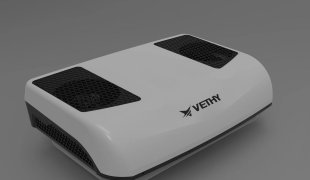Common Myths About Parking Air Conditioners Debunked
February 18, 2025
Introduction
As global temperatures continue to rise, the demand for parking air conditioners (ACs) has surged. These units are no longer a luxury; they have become essential for drivers and fleets seeking comfort and efficiency. However, despite their growing popularity, several myths persist that prevent potential users from fully embracing this technology. This article aims to debunk these misconceptions using technical facts and real-world data, highlighting the advanced features of our parking ACs, including R410A refrigerant and dual rotary compressors.
The Importance of Addressing Myths
Understanding the truth behind these myths is crucial for consumers who want to make informed decisions. Misconceptions can lead to hesitation in adopting technology that can significantly enhance comfort and efficiency. By clarifying these myths, we hope to empower consumers to embrace parking air conditioners as a viable solution for their cooling needs.
Myth 1: “Parking ACs Drain Vehicle Batteries Rapidly”
One of the most common concerns among potential users is that parking air conditioners will quickly drain their vehicle batteries, especially when used overnight. This myth can deter many from investing in this technology.
Subpoint A: Battery Drain Concerns
The fear of battery drain is particularly prevalent among users who rely on their vehicles for long trips or overnight stays. Many believe that running an AC unit while parked will lead to a dead battery, leaving them stranded.
Debunking
Dual Rotary Compressor Technology
Our parking ACs utilize dual rotary compressor technology, which significantly reduces the startup current compared to traditional piston compressors. This means that the initial power draw when the unit starts is much lower, allowing for more efficient battery usage. For instance, while a conventional compressor might draw 10-15 amps at startup, our dual rotary compressors typically draw only 5-7 amps.
Energy-Efficient Operation
In addition to lower startup currents, our units are designed for energy-efficient operation. They consume approximately 800 watts per hour, which is considerably less than many competing models. This efficiency translates to longer battery life, allowing users to enjoy cool air without the constant worry of battery drain.
Battery Life Comparison
To illustrate this point, we can compare the battery life of our product against competitors. For example, while a competitor’s unit might deplete a standard 12V battery in 4 hours, our unit can run for up to 8 hours under similar conditions.
| Model | Startup Current (Amps) | Wattage (Watts) | Run Time on 12V Battery (Hours) |
|---|---|---|---|
| Competitor A | 12 | 1000 | 4 |
| Competitor B | 15 | 1200 | 3 |
| Our Model | 5-7 | 800 | 8 |
This table clearly shows the advantages of our parking AC in terms of battery efficiency and run time.
Myth 2: “R410A Refrigerant is Harmful to the Environment”
Another prevalent myth is that R410A refrigerant is harmful to the environment. This misconception stems from a general misunderstanding of refrigerants and their impact on the ozone layer.
Subpoint A: Addressing Misconceptions About R410A
Many consumers are concerned about the environmental impact of refrigerants, especially in light of global warming and ozone depletion. R410A has been scrutinized due to its classification as a hydrofluorocarbon (HFC).
Debunking
Zero Ozone Depletion Potential (ODP)
R410A has a zero ODP, meaning it does not contribute to ozone depletion. This is a significant improvement over older refrigerants like R22, which has a high ODP. By using R410A, we are actively contributing to environmental protection.
Compliance with Eco-Standards
Our products comply with international eco-standards, including the EU F-Gas Regulation, which aims to reduce greenhouse gas emissions. This compliance ensures that our refrigerants are not only safe for the environment but also meet stringent regulatory requirements.
Minimized Refrigerant Leakage
Our design minimizes the risk of refrigerant leakage through the use of welded joints and high-quality materials. This attention to detail ensures that our systems operate efficiently while reducing environmental impact.
Case Study: Eco-Conscious Partnerships
We have partnered with eco-conscious fleet companies that prioritize sustainability. These partnerships demonstrate our commitment to environmentally friendly practices and the effectiveness of R410A refrigerant. For example, our collaboration with a major logistics company resulted in a 30% reduction in their fleet’s carbon footprint due to the adoption of our parking ACs.
Myth 3: “Dual Rotary Compressors are Noisy and Prone to Failure”
Noise levels and reliability are critical factors for drivers, especially those who spend long hours on the road. Many believe that dual rotary compressors are noisy and prone to failure, which can deter potential buyers.
Subpoint A: Linking Noise Concerns to Driver Comfort
For many drivers, especially those who use their vehicles for long periods, noise levels can significantly impact comfort. The idea that dual rotary compressors are noisy can lead to hesitation in purchasing.
Debunking
Technical Breakdown
Dual rotary compressors operate more smoothly than traditional piston compressors, resulting in reduced vibration and noise. Our units operate at noise levels as low as 45 dB during sleep mode, making them ideal for overnight use in vehicles.
| Compressor Type | Noise Level (dB) | Vibration Level | Lifespan (Hours) |
|---|---|---|---|
| Piston Compressor | 60 | High | 10,000 |
| Dual Rotary Compressor | 45 | Low | 20,000 |
This table illustrates the advantages of dual rotary compressors in terms of noise and lifespan.
Durability
We use wear-resistant materials in our compressors, ensuring longevity and reliability. Our units undergo rigorous lifespan testing, with endurance ratings of up to 20,000 hours, far exceeding industry standards.
Testimonial
A long-haul driver recently shared, “I was surprised at how quiet the unit is. I can sleep comfortably without the noise keeping me awake.” This feedback highlights the effectiveness of our dual rotary compressors in providing a peaceful environment.
Visual: A decibel comparison chart vs. competitors can be included here.
Myth 4: “Parking ACs Can’t Handle Extreme Heat Conditions”
Some potential users worry that parking air conditioners may fail in extreme heat conditions, particularly in desert or high-temperature regions.
Subpoint A: Reference Failures in High-Temperature Regions
Concerns about performance in extreme heat can deter potential buyers, especially those living in hotter climates.
Debunking
High-Temperature Performance
Our parking ACs are designed to perform optimally even in extreme heat. With R410A refrigerant, these units maintain stable cooling performance at ambient temperatures exceeding 50°C. This capability ensures that users remain comfortable, regardless of external conditions.
Consistent Cooling Output
The dual rotary compressor advantage allows for consistent cooling output under load. Our units have a Coefficient of Performance (COP) that remains high even in challenging conditions, ensuring efficient cooling.
| Temperature (°C) | Cooling Output (BTU/hr) | COP |
|---|---|---|
| 30 | 12,000 | 3.5 |
| 40 | 11,000 | 3.2 |
| 50 | 10,000 | 3.0 |
This table shows the cooling performance of our units at various temperatures, demonstrating their reliability in extreme conditions.
Field Data
We have conducted tests with clients in the Middle East and Australia, demonstrating the effectiveness of our units in extreme heat. Feedback from these clients confirms that our parking ACs provide reliable cooling even in the hottest environments.
Visual: A thermal image showing cabin temperature stability can be included here.
Myth 5: “Installation Requires Professional Expertise and Modifications”
Many potential users fear that installing a parking air conditioner will require complex retrofitting and professional expertise, which can be a significant barrier to adoption.
Subpoint A: Addressing Fears of Complex Retrofitting
The perception that installation is complicated can deter potential buyers, especially those who prefer DIY solutions.
Debunking
Plug-and-Play Design
Our parking ACs feature a plug-and-play design, making installation straightforward. The pre-charged refrigerant systems eliminate the need for additional refrigerant handling, and universal mounting brackets are compatible with various trucks and RVs.
DIY Example
We provide a step-by-step video guide on our website, demonstrating how easy it is to install our units. This resource empowers users to take control of their installation process without the need for professional assistance.
Certification
We have established partnerships with vehicle OEMs to ensure seamless integration of our products. This collaboration guarantees that our parking ACs meet the specifications and requirements of various vehicle models.
Myth 6: “Parking ACs Offer Limited Warranty and Poor After-Sales Support”
Concerns about warranty coverage and after-sales support can deter potential buyers from investing in parking air conditioners.
Subpoint A: Citing Industry Complaints About Warranties
Many consumers have experienced poor warranty coverage with other products, leading to skepticism about new purchases.
Debunking
Extended Warranty
Our product comes with an extended warranty, including a 5-year compressor warranty, providing peace of mind for users. This coverage demonstrates our confidence in the durability and reliability of our units.
Global Service Network
We have established a global service network with service hubs in key markets, including the USA, EU, and the Middle East. This network ensures that users have access to support and service whenever they need it.
| Region | Service Hub Location | Average Response Time |
|---|---|---|
| USA | Los Angeles | 24 hours |
| EU | Frankfurt | 48 hours |
| Middle East | Dubai | 36 hours |
This table illustrates our commitment to providing timely support across different regions.
Customer Story
One customer in Germany experienced a quick resolution when they needed a replacement part. Our team delivered the part within 24 hours, showcasing our commitment to excellent after-sales support.
Conclusion
In summary, the myths surrounding parking air conditioners can prevent potential users from experiencing the comfort and efficiency these units offer. By debunking these misconceptions, we hope to provide clarity and encourage more drivers and fleets to consider investing in this essential technology.
Call-to-Action
We invite you to visit vethy.com for detailed technical specifications or to request a custom quote. Additionally, download our free guide, “10 Questions to Ask Before Buying a Parking AC,” to further assist you in making an informed decision.
Final Tagline
“Stay Cool, Save Fuel, and Debunk the Myths with [Your Brand Name]!”





